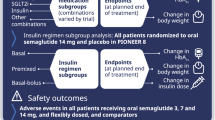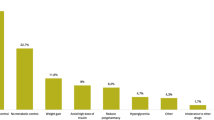Abstract
Aims
Data on the effect of liraglutide on glycemic endpoints in people with T2DM using multiple daily insulin injections (MDI) are scarce, especially in the context of ethnicity.
Methods
This is a secondary analysis of the placebo-controlled randomized clinical “MAGNA VICTORIA” trials in Western European (WE) and South Asian (SA) people with T2DM. Participants had inadequate glycemic control despite using metformin and/or sulfonylurea derivatives and/or insulin. Participants were assigned to liraglutide (1.8 mg) or placebo for 6 months, in addition to standard care. The primary endpoint number of participants reaching target HbA1c was compared for liraglutide versus placebo in the complete dataset and MDI-treated participants using Chi-square test. Liraglutide’s efficacy in WE and SA was compared using a generalized linear model.
Results
Forty-five subjects were randomized to liraglutide and 51 to placebo. In each group, one participant did not complete the study. Liraglutide-treated patients reached target HbA1c more frequently: 23/45 (51%) vs 11/51 (22%), relative probability 2.4 (1.3–4.3), p = 0.002. Subgroup analysis in 43 MDI participants showed that the proportion reaching target HbA1c using liraglutide was significantly higher than in placebo: 9/22 (41%) vs 1/21 (5%), p = 0.005. There was no difference between WE and SA in terms of liraglutide efficacy (p = 0.18).
Conclusions
Liraglutide treatment resulted in increased chance of reaching target HbA1c as compared to placebo. Liraglutide efficacy was sustained in participants using MDI regimens and those of SA descent. Liraglutide should be considered for T2DM people with inadequate glycemic control despite MDI.

Similar content being viewed by others
References:
Davies MJ, D’Alessio DA, Fradkin J et al (2018) Management of hyperglycaemia in type 2 diabetes,2018. A consensus report by the American diabetes association (ADA) and the European association for the study of diabetes (EASD). Diabetologia 61(12):2461–2498
Gloyn AL, Drucker DJ (2018) Precision medicine in the management of type 2 diabetes. lancet Diabetes Endocrinol 6(11):891–900
Ahlqvist E, Storm P, Käräjämäki A et al (2018) Novel subgroups of adult-onset diabetes and their association with outcomes: a data-driven cluster analysis of six variables. Lancet Diabetes Endocrinol 6(5):361–369
Patel SA, Shivashankar R, Ali MK et al (2016) Is the “South Asian Phenotype” unique to South Asians?: comparing cardiometabolic risk factors in the CARRS and NHANES studies. Glob Heart 11(1):89-96.e3
Bakker LE, Sleddering MA, Schoones JW, Meinders AE, Jazet IM (2013) Pathogenesis of type 2 diabetes in South Asians. Eur J Endocrinol 169(5):R99–R114
Narayan KMV, Kanaya AM (2020) Why are South Asians prone to type 2 diabetes? A hypothesis based on underexplored pathways. Diabetologia 63:1103–1109
Narayan KM (2016) Type 2 diabetes: why we are winning the battle but losing the war? 2015 Kelly west award lecture. Diabetes Care 39(5):653–663
Gujral UP, Pradeepa R, Weber MB, Narayan KM, Mohan V (2013) Type 2 diabetes in South Asians: similarities and differences with white Caucasian and other populations. Ann New York Acad Sci 1281(1):51–63
Staimez LR, Weber MB, Ranjani H et al (2013) Evidence of reduced β-cell function in Asian Indians with mild dysglycemia. Diabetes Care 36(9):2772–2778
Shah A, Kanaya AM (2014) Diabetes and associated complications in the South Asian population. Curr Cardiol Rep 16(5):476
Riddle MC, Rosenstock J, Vlajnic A, Gao L (2014) Randomized, 1-year comparison of three ways to initiate and advance insulin for type 2 diabetes: twice-daily premixed insulin versus basal insulin with either basal-plus one prandial insulin or basal-bolus up to three prandial injections. Diabetes Obes Metab 16(5):396–402
Davies ML, Pham DQ, Drab SR (2016) GLP1-RA Add-on therapy in patients with type 2 diabetes currently on a bolus containing insulin regimen. Pharmacotherapy 36(8):893–905
Marso SP, Daniels GH, Brown-Frandsen K et al (2016) Liraglutide and cardiovascular outcomes in type 2 diabetes. New Engl J Med 375(4):311–322
Lind M, Hirsch IB, Tuomilehto J et al (2015) Liraglutide in people treated for type 2 diabetes with multiple daily insulin injections: randomised clinical trial (MDI Liraglutide trial). BMJ (Clin Res Ed) 351:h5364
Vanderheiden A, Harrison L, Warshauer J, Li X, Adams-Huet B, Lingvay I (2016) Effect of adding liraglutide vs placebo to a high-dose lnsulin regimen in patients with type 2 diabetes: a randomized clinical trial. JAMA Intern Med 176(7):939–947
Jones AG, McDonald TJ, Shields BM et al (2016) Markers of beta-cell failure predict poor glycemic response to GLP-1 receptor agonist therapy in type 2 diabetes. Diabetes Care 39(2):250–257
Ohbatake A, Yagi K, Karashima S et al (2019) C-peptide area under the curve at glucagon stimulation test predicts glucose improvements by GLP-1 receptor analogue: a retrospective observational study. Diabetes Ther 10(2):673–681
Bizino MB, Jazet IM, Westenberg JJM et al (2019) Effect of liraglutide on cardiac function in patients with type 2 diabetes mellitus: randomized placebo-controlled trial. Cardiovasc Diabetol 18(1):55
Paiman EHM, van Eyk HJ, van Aalst MM et al (2019) Effect of liraglutide on cardiovascular function and myocardial tissue characteristics in type 2 diabetes patients of South Asian descent living in the Netherlands: a double-blind, randomized, placebo-controlled trial. J Magn Reson Imaging JMRI 51:1679–1688
van Eyk HJ, Paiman EHM, Bizino MB et al (2019) A double-blind, placebo-controlled, randomised trial to assess the effect of liraglutide on ectopic fat accumulation in South Asian type 2 diabetes patients. Cardiovasc Diabetol 18(1):87
Drucker DJ (2018) Mechanisms of action and therapeutic application of glucagon-like peptide-1. Cell Metab 27(4):740–756
Lane W, Weinrib S, Rappaport J, Hale C (2014) The effect of addition of liraglutide to high-dose intensive insulin therapy: a randomized prospective trial. Diabetes Obes Metab 16(9):827–832
Flat-Sugar Trial Investigators (2016) Glucose variability in a 26-week randomized comparison of mealtime treatment with rapid-acting insulin versus GLP-1 agonist in participants with type 2 diabetes at high cardiovascular risk. Diabetes Care 39(6):973–981
Anirban M, Soumyabrata RC, Debmalya S, Bhattacharjee K (2018) Liraglutide - Indian experience. Indian J Endocrinol Metab 22(6):818–826
Kim YG, Hahn S, Oh TJ, Park KS, Cho YM (2014) Differences in the HbA1c-lowering efficacy of glucagon-like peptide-1 analogues between Asians and non-Asians: a systematic review and meta-analysis. Diabetes Obes Metab 16(10):900–909
Jainandunsing S, Ozcan B, Rietveld T et al (2015) Failing beta-cell adaptation in South Asian families with a high risk of type 2 diabetes. Acta Diabetol 52(1):11–19
Drucker DJ (2016) The cardiovascular biology of glucagon-like peptide-1. Cell Metab 24(1):15–30
Snel M, Gastaldelli A, Ouwens DM et al (2012) Effects of adding exercise to a 16-week very low-calorie diet in obese, insulin-dependent type 2 diabetes mellitus patients. J Clin Endocrinol Metab 97(7):2512–2520
Courcoulas AP, Belle SH, Neiberg RH et al (2015) Three-year outcomes of bariatric surgery vs lifestyle intervention for type 2 diabetes mellitus treatment: a randomized clinical trial. JAMA Surg 150(10):931–940
Seferovic PM, Ponikowski P, Anker SD et al (2019) Clinical practice update on heart failure 2019: pharmacotherapy, procedures, devices and patient management an expert consensus meeting report of the heart failure association of the European society of cardiology. Eur J Heart Fail 21(10):1169–1186
Reznik Y, Cohen O, Aronson R et al (2014) Insulin pump treatment compared with multiple daily injections for treatment of type 2 diabetes (OpT2mise): a randomised open-label controlled trial. Lancet (Lond Engl) 384(9950):1265–1272
Acknowledgements
We are grateful to all members of the MAGNA VICTORIA study group (see supplemental material) who assisted in recruitment of participants. We thank Mrs. B. Ladan-Eygenraam (Department of Internal Medicine, Leiden University Medical Center, The Netherlands) for assistance in the laboratory.
Funding
M.B. Bizino, H.J. van Eyk, P.C.N. Rensen, P.H. Geelhoed-Duijvestijn, A.V. Kharaghjitsing, E.H.M. Paiman, J.W. Smit, H.J. Lamb: No funding received. I.M. Jazet: unrestricted grant from Roba Metals B.V. IJsselstein (Utrecht, The Netherlands).
Author information
Authors and Affiliations
Corresponding author
Ethics declarations
Conflict of interest
I.M. Jazet received an unrestricted grant form Roba Metals B.V. IJsselstein (Utrecht, The Netherlands). All authors declare that they have no conflict of interest.
Ethical approval
The study was approved by the Leiden University Medical Center Medical Ethics Committee: Commissie Medische Ethiek. Tthe study was performed in accordance with the ethical standards as laid down in the 1964 Declaration of Helsinki and its later amendments or comparable ethical standards. The MAGNA VICTORIA studies have been registered prospectively: NCT01761318 (January 4, 2013) and NCT02660047 (October 13, 2016).
Informed consent
Written informed consent was obtained from all participants before study.
Additional information
Managed by Massimo Porta.
Publisher's Note
Springer Nature remains neutral with regard to jurisdictional claims in published maps and institutional affiliations.
Electronic supplementary material
Below is the link to the electronic supplementary material.
Rights and permissions
About this article
Cite this article
Bizino, M.B., Jazet, I.M., van Eyk, H.J. et al. Efficacy of liraglutide on glycemic endpoints in people of Western European and South Asian descent with T2DM using multiple daily insulin injections: results of the MAGNA VICTORIA studies. Acta Diabetol 58, 485–493 (2021). https://doi.org/10.1007/s00592-020-01635-0
Received:
Accepted:
Published:
Issue Date:
DOI: https://doi.org/10.1007/s00592-020-01635-0




